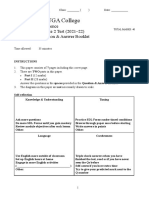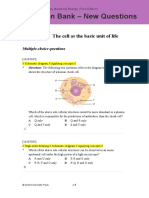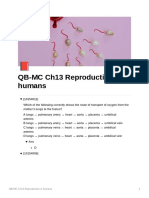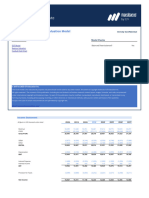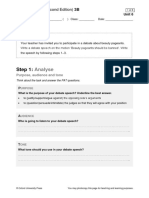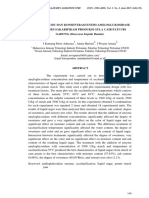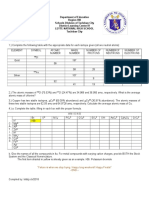Part ІІ Microscopic World I: Ans: A
Part ІІ Microscopic World I: Ans: A
Uploaded by
Gabriel FungCopyright:
Available Formats
Part ІІ Microscopic World I: Ans: A
Part ІІ Microscopic World I: Ans: A
Uploaded by
Gabriel FungOriginal Title
Copyright
Available Formats
Share this document
Did you find this document useful?
Is this content inappropriate?
Copyright:
Available Formats
Part ІІ Microscopic World I: Ans: A
Part ІІ Microscopic World I: Ans: A
Uploaded by
Gabriel FungCopyright:
Available Formats
HKDSE CHEMISTRY A Modern View (Second Edition)
(For Chemistry and Combined Science) Part II
Part ІІ Microscopic World I
1. Which of the following type(s) of particles does the ion formed from H atom
contain?
(1) Proton
(2) Neutron
(3) Electron
A. (1) only
B. (2) only
C. (1) and (3) only
D. (2) and (3) only
Ans: A
2. The diagram below shows the electronic arrangement of a particle X (p and n
represent protons and neutrons respectively).
electron
X should be
A. a sodium atom.
B. a sodium ion.
C. a magnesium atom.
D. a magnesium ion.
Ans: B
© Aristo Educational Press Ltd. 2016 1
HKDSE CHEMISTRY A Modern View (Second Edition)
(For Chemistry and Combined Science) Part II
3. Which of the following electron diagrams is INCORRECT?
A.
B.
C.
D.
Ans: C
4. Which of the following combinations is correct?
Formula Name
A. Cl Chromate ion
B. N 3
Nitrite ion
C. S2 Sulphide ion
D. SO3
Sulphate ion
Ans: C
5. Which of the following pairs of atoms show similar chemical properties?
A. and
B. and
C. and
D. and
Ans: C
© Aristo Educational Press Ltd. 2016 2
HKDSE CHEMISTRY A Modern View (Second Edition)
(For Chemistry and Combined Science) Part II
6. Francium is a Group I element. Which of the following statements about
francium is INCORRECT?
A. It reacts explosively with water.
B. It is a silvery solid.
C. It is less reactive than sodium.
D. It can conduct electricity.
Ans: C
7. Which of the following pairs of elements in Group I and Group VII of the
Periodic Table would react with each other most vigorously?
Group I Group VII
A. Sodium Iodine
B. Sodium Bromine
C. Potassium Chlorine
D. Potassium Fluorine
Ans: D
8. Which of the following properties show(s) that the ionic bonds between the ions
in potassium chloride are strong?
(1) Potassium chloride is soluble in water.
(2) Potassium chloride has a high melting point.
(3) Potassium chloride can conduct electricity in aqueous solution.
A. (1) only
B. (2) only
C. (1) and (3) only
D. (2) and (3) only
Ans: B
9. Element W has an isotope . Which of the following statements are correct?
(1) W belongs to Group V of the Periodic Table.
(2) W can react with sodium to form an ionic compound.
(3) W has 17 protons.
A. (1) and (2) only
B. (1) and (3) only
C. (2) and (3) only
D. (1), (2) and (3)
Ans: C
© Aristo Educational Press Ltd. 2016 3
HKDSE CHEMISTRY A Modern View (Second Edition)
(For Chemistry and Combined Science) Part II
10. Which of the following ions has the same number of electrons as the sodium ion,
Na+?
A. Li+
B. F−
C. Cl−
D. Ca2+
Ans: B
11. X and Y are two different elements with 9 protons and 20 protons respectively.
They combine to form a compound with the formula
A. Y2X.
B. X2Y.
C. YX2.
D. XY2.
Ans: C
12. The atomic numbers of two elements X and Y are 11 and 16 respectively. The
compound formed from X and Y
A. is a gas at room temperature and pressure.
B. is not an electrolyte.
C. has a chemical formula of XY2.
D. can conduct electricity when molten.
Ans: D
13. Which of the following combinations is correct?
Ion Colour
A. Nickel(II) ion Red
B. Cobalt(II) ion Green
C. Iron(II) ion Orange
D. Iron(III) ion Brown
Ans: D
© Aristo Educational Press Ltd. 2016 4
HKDSE CHEMISTRY A Modern View (Second Edition)
(For Chemistry and Combined Science) Part II
14. Which of the following compounds gives a green solution when dissolved in
water?
A. Potassium permanganate
B. Nickel(II) sulphate
C. Zinc chloride
D. Iron(II) sulphate
Ans: B
15. The following electron diagram (only the outermost shell electrons are shown)
represents a compound formed from three different elements H, N and Cl.
Which of the following statements are correct?
(1) Ionic bonds exist in the compound.
(2) Dative covalent bond exists in the compound.
(3) The ions are held together by van der Waals’ forces in the giant ionic
structure.
A. (1) and (2) only
B. (1) and (3) only
C. (2) and (3) only
D. (1), (2) and (3)
Ans: A
16. Which of the following substances can conduct electricity in the solid state?
A. Copper(II) chloride
B. Sodium chloride
C. Dry ice
D. Copper
Ans: D
© Aristo Educational Press Ltd. 2016 5
HKDSE CHEMISTRY A Modern View (Second Edition)
(For Chemistry and Combined Science) Part II
17. Metals are good conductors of electricity because
A. the metals can form ions by losing electrons.
B. the metal atoms are free to move to conduct electricity.
C. the outermost shell electrons of each metal atom are free to move to conduct
electricity.
D. all the electrons are free to move to conduct electricity.
Ans: C
18. Which of the following combinations are correct?
Substance Bonds/attractions holding
constituent particles
(1) Calcium oxide Ionic bonds
(2) Copper Metallic bonds
(3) Neon Van der Waals’ forces
A. (1) and (2) only
B. (1) and (3) only
C. (2) and (3) only
D. (1), (2) and (3)
Ans: D
19. Which of the following diagrams best represents water vapour? (Different sizes
of circles represent atoms of different elements.)
A. B.
C. D.
Ans: B
© Aristo Educational Press Ltd. 2016 6
HKDSE CHEMISTRY A Modern View (Second Edition)
(For Chemistry and Combined Science) Part II
20. Which of the following combinations is INCORRECT?
Substance Structure
A. Diamond Giant covalent structure
B. Quartz Simple molecular structure
C. Potassium chloride Giant ionic structure
D. Dry ice Simple molecular structure
Ans: B
© Aristo Educational Press Ltd. 2016 7
You might also like
- Painting Question and AnswerDocument38 pagesPainting Question and AnswerRamdas100% (6)
- Chemistry Hkcee Past Paper Microscopic WorldDocument7 pagesChemistry Hkcee Past Paper Microscopic WorldAnn MaNo ratings yet
- P S CL K Ca: F3 First Term RevisionDocument6 pagesP S CL K Ca: F3 First Term Revisionjonas hoNo ratings yet
- CH 14.1 Quiz & AnsDocument4 pagesCH 14.1 Quiz & AnsAlex ChenNo ratings yet
- F.3 Chem Test 2 19-20Document5 pagesF.3 Chem Test 2 19-20Carina WongNo ratings yet
- Air and AtmosphereDocument12 pagesAir and Atmospherebob leowNo ratings yet
- QB Update 1A ch02 eDocument8 pagesQB Update 1A ch02 e008 proartNo ratings yet
- PartII Planet Earth MCDocument31 pagesPartII Planet Earth MCDavid LouNo ratings yet
- Objective Questions: Qbank/Biology Form 4Document76 pagesObjective Questions: Qbank/Biology Form 4zazaNo ratings yet
- 英華女學校 2020 Mock Paper 1A Answer (at bottom) - TikadoDocument13 pages英華女學校 2020 Mock Paper 1A Answer (at bottom) - TikadoOof GucciNo ratings yet
- Chapter 12 Multiple-Choice QuestionsDocument25 pagesChapter 12 Multiple-Choice Questionsteresa tsoiNo ratings yet
- Scicent SQ U2 5-6 SetA Final eDocument4 pagesScicent SQ U2 5-6 SetA Final esteve LNo ratings yet
- A4 QB-MC Ch03 Movement of Substances Across Cell MembraneDocument22 pagesA4 QB-MC Ch03 Movement of Substances Across Cell MembraneReg ChooNo ratings yet
- Part I Introducing Chemistry MCDocument6 pagesPart I Introducing Chemistry MCDavid LouNo ratings yet
- Chemistry Paper 1Document14 pagesChemistry Paper 1Ngai Ivan CHANNo ratings yet
- HKUGA College: S1 Science Module 2 Test (2021-22) Question & Answer BookletDocument7 pagesHKUGA College: S1 Science Module 2 Test (2021-22) Question & Answer Booklet6A 12 Nathan Leung 梁逸曦No ratings yet
- 7 Metallic Bonding & Ionic Bonding (Teacher)Document33 pages7 Metallic Bonding & Ionic Bonding (Teacher)otto wongNo ratings yet
- Chapter 5 - Food and HumansDocument11 pagesChapter 5 - Food and HumansミーチェルNo ratings yet
- 8 Covalent Bonding (Teacher)Document32 pages8 Covalent Bonding (Teacher)otto wongNo ratings yet
- Baptist Lui Ming Choi Secondary School First Term Examination (2012-2013) Form 3 ChemistryDocument12 pagesBaptist Lui Ming Choi Secondary School First Term Examination (2012-2013) Form 3 ChemistryyuNo ratings yet
- Phy BK Ans 3aDocument24 pagesPhy BK Ans 3aapi-253498969No ratings yet
- Chapter 2 - The Cell (Bio MC)Document6 pagesChapter 2 - The Cell (Bio MC)Emily LiNo ratings yet
- Term Exam EngDocument89 pagesTerm Exam Engchristielam123No ratings yet
- NSSBIO3E - QB Update - 1A - eDocument42 pagesNSSBIO3E - QB Update - 1A - ekatie yuNo ratings yet
- S5 Ume Maco P1Document12 pagesS5 Ume Maco P1Mario WongNo ratings yet
- Paper 1BDocument14 pagesPaper 1Bw cooNo ratings yet
- WS Part10.1 TE eDocument5 pagesWS Part10.1 TE eIn Kwan Adele YauNo ratings yet
- Test: Waves: Section A: CoreDocument14 pagesTest: Waves: Section A: Coreapi-3705610No ratings yet
- HK JS Geography Water ProblemDocument3 pagesHK JS Geography Water ProblemParkinNo ratings yet
- A4 QB-MC Ch08 Transport in HumansDocument23 pagesA4 QB-MC Ch08 Transport in HumansReg ChooNo ratings yet
- S5 Ume Maco P2Document15 pagesS5 Ume Maco P2Mario WongNo ratings yet
- F3 MTA Math2019 SolutionDocument9 pagesF3 MTA Math2019 Solutionpgkbgjrh5pNo ratings yet
- IJSO Ex DSE Bio Disease MCDocument3 pagesIJSO Ex DSE Bio Disease MC葡萄蘿蔔No ratings yet
- A4 QB-MC Ch13 Reproduction in HumansDocument21 pagesA4 QB-MC Ch13 Reproduction in HumansReg ChooNo ratings yet
- Worksheet Part1 TE eDocument39 pagesWorksheet Part1 TE eEugenia100% (2)
- Scicent Quiz U7-1 Final eDocument3 pagesScicent Quiz U7-1 Final ephoebeqiliangNo ratings yet
- Multiple-Choice Questions: Biology: Food and Humans Combined Science: Chapter 6 Food and HumansDocument25 pagesMultiple-Choice Questions: Biology: Food and Humans Combined Science: Chapter 6 Food and Humans何柏濤No ratings yet
- IT Chem F5 Mid-Year Examination (E)Document10 pagesIT Chem F5 Mid-Year Examination (E)Norzawati NoordinNo ratings yet
- Scicent SQ U8 1-2 SetA Final eDocument6 pagesScicent SQ U8 1-2 SetA Final eApple LouNo ratings yet
- 2006 Form 3 Physics Half-Yearly Exam (Dec 2006)Document4 pages2006 Form 3 Physics Half-Yearly Exam (Dec 2006)Raistlin Chan Ching KitNo ratings yet
- Leapotswe International School: Cambridge IGCSEDocument16 pagesLeapotswe International School: Cambridge IGCSEShepherd W NgwenyaNo ratings yet
- QB 05 DRQ 01 eDocument51 pagesQB 05 DRQ 01 eYeet YeetNo ratings yet
- Unit 2 Exploring The Living World: Multiple-Choice QuestionsDocument18 pagesUnit 2 Exploring The Living World: Multiple-Choice QuestionsVincent NGNo ratings yet
- New Senior Secondary Physics at Work (Second Edition)Document10 pagesNew Senior Secondary Physics at Work (Second Edition)Jeffrey YuetNo ratings yet
- 3 Geog T2, Q 1819Document6 pages3 Geog T2, Q 1819Sze Ying HuiNo ratings yet
- Structured Questions: HKDSE Chemistry A Modern View Part VIII Chemical Reactions and EnergyDocument21 pagesStructured Questions: HKDSE Chemistry A Modern View Part VIII Chemical Reactions and EnergyNg Swee Loong StevenNo ratings yet
- s2 History-Set 2Document10 pagess2 History-Set 2cheeerrryyllNo ratings yet
- 2 Supplementary Exercise Microscopic World I (Question)Document147 pages2 Supplementary Exercise Microscopic World I (Question)RyanNo ratings yet
- Scicent SQ U8 3-4 SetA Final eDocument7 pagesScicent SQ U8 3-4 SetA Final eApple LouNo ratings yet
- F1 2021-2022 L&S Final Term ExamDocument6 pagesF1 2021-2022 L&S Final Term ExamchloeNo ratings yet
- Chem MC Content (1) MergedDocument171 pagesChem MC Content (1) MergedjlkdinhkNo ratings yet
- Physics: Question-Answer BookDocument16 pagesPhysics: Question-Answer Bookjonas hoNo ratings yet
- CH 1 Introducing BiologyDocument7 pagesCH 1 Introducing BiologyHa YeungNo ratings yet
- Chemistry Paper 2Document6 pagesChemistry Paper 2Ngai Ivan CHANNo ratings yet
- WS E6 U1 Eng AnsDocument5 pagesWS E6 U1 Eng AnsMatthew LongNo ratings yet
- MSS 1718MockPaper2Document8 pagesMSS 1718MockPaper2Kelvin ChowNo ratings yet
- Paper 1 MSDocument24 pagesPaper 1 MSsultanhsu168No ratings yet
- 02 - The Cell As A Basic Unit of LifeDocument5 pages02 - The Cell As A Basic Unit of LifeChan SiumingNo ratings yet
- Chapter 14 SQDocument6 pagesChapter 14 SQ008 proartNo ratings yet
- Chapter 1 Chemical Reactions and EquationsDocument3 pagesChapter 1 Chemical Reactions and Equations༄ɪɴd᭄乂Sɳιρҽɾ乂100% (1)
- MWI Ch.6 MCPPDocument8 pagesMWI Ch.6 MCPPEddy Laurent OffiNo ratings yet
- 2021 1 Test S4 Math QuestionDocument14 pages2021 1 Test S4 Math QuestionGabriel FungNo ratings yet
- Assessment & Student EportfolioDocument28 pagesAssessment & Student EportfolioGabriel FungNo ratings yet
- IB BusMan 12 Resources EPQ12Document3 pagesIB BusMan 12 Resources EPQ12Gabriel FungNo ratings yet
- IB Bm2tr 2 Resources Answers5Document4 pagesIB Bm2tr 2 Resources Answers5Gabriel FungNo ratings yet
- IB Bm2tr 3 Resources Answers9Document3 pagesIB Bm2tr 3 Resources Answers9Gabriel FungNo ratings yet
- IB Bm2tr 1 Resources Answers1Document2 pagesIB Bm2tr 1 Resources Answers1Gabriel FungNo ratings yet
- IB BusMan 1 Planning Sow1Document3 pagesIB BusMan 1 Planning Sow1Gabriel FungNo ratings yet
- IB Bm2tr 5 Resources Answers2Document3 pagesIB Bm2tr 5 Resources Answers2Gabriel FungNo ratings yet
- IB Bm2tr 2 Resources Answers6Document4 pagesIB Bm2tr 2 Resources Answers6Gabriel FungNo ratings yet
- Build A Presentation With Macabacus - Excel V1Document12 pagesBuild A Presentation With Macabacus - Excel V1Gabriel FungNo ratings yet
- Oxford English Second Edition 3B Unit 6: Movers and ShakersDocument4 pagesOxford English Second Edition 3B Unit 6: Movers and ShakersGabriel FungNo ratings yet
- IB BusMan 38 Resources EPQ38Document3 pagesIB BusMan 38 Resources EPQ38Gabriel FungNo ratings yet
- Business Valuation Model (Complete)Document16 pagesBusiness Valuation Model (Complete)Gabriel FungNo ratings yet
- Build A Presentation With Macabacus - CFI TeamDocument2 pagesBuild A Presentation With Macabacus - CFI TeamGabriel FungNo ratings yet
- Oxford English Second Edition 3B Unit 8: World HousingDocument4 pagesOxford English Second Edition 3B Unit 8: World HousingGabriel FungNo ratings yet
- Oxford English Second Edition 3A Unit 2: Learn To RespectDocument4 pagesOxford English Second Edition 3A Unit 2: Learn To RespectGabriel FungNo ratings yet
- Inversion: © Oxford University PressDocument32 pagesInversion: © Oxford University PressGabriel FungNo ratings yet
- Additional: Revision ExerciseDocument7 pagesAdditional: Revision ExerciseGabriel FungNo ratings yet
- Agreement: © Oxford University PressDocument24 pagesAgreement: © Oxford University PressGabriel FungNo ratings yet
- Conditional Sentences About Unfulfilled Past Situations: © Oxford University PressDocument23 pagesConditional Sentences About Unfulfilled Past Situations: © Oxford University PressGabriel FungNo ratings yet
- Using Although/though and Despite/in Spite Of: Oxford English (Second Edition) 3BDocument6 pagesUsing Although/though and Despite/in Spite Of: Oxford English (Second Edition) 3BGabriel FungNo ratings yet
- Using Would Rather (Than) And: Prefer (To)Document28 pagesUsing Would Rather (Than) And: Prefer (To)Gabriel FungNo ratings yet
- Oe3bu6 p57 Writing SupportDocument8 pagesOe3bu6 p57 Writing SupportGabriel FungNo ratings yet
- Publication 4 29484 1037Document9 pagesPublication 4 29484 1037peterNo ratings yet
- Control of Microorganisms Unit 7Document67 pagesControl of Microorganisms Unit 7Naseca100% (1)
- War Gas ReportDocument30 pagesWar Gas ReportDheeraj TyagiNo ratings yet
- 100-001 Tubular Metal Braid QQ-B-575B/A-A-59569 ASTM B33 Tin Coated CopperDocument1 page100-001 Tubular Metal Braid QQ-B-575B/A-A-59569 ASTM B33 Tin Coated CopperPhillipe GarkauskasNo ratings yet
- Rubia Fleet HD 500 20W-50: Key DataDocument2 pagesRubia Fleet HD 500 20W-50: Key DataAdnanNo ratings yet
- Thermo 1Document15 pagesThermo 1CLAUDETTE CLYDE GUERRERONo ratings yet
- Chloroform - Wikipedia PDFDocument15 pagesChloroform - Wikipedia PDFHARISH PECNo ratings yet
- New Microsoft Word DocumentDocument5 pagesNew Microsoft Word DocumentVismay PatelNo ratings yet
- (ACS Symposium Series 663) J. Edward Glass (Eds.) - Technology For Waterborne Coatings-American Chemical Society (1997)Document311 pages(ACS Symposium Series 663) J. Edward Glass (Eds.) - Technology For Waterborne Coatings-American Chemical Society (1997)Glasst Innovacion 2019No ratings yet
- Pengaruh Suhu Dan Konsentrasi Enzim Amiloglukosidase Pada Proses Sakarifikasi Produksi Gula Cair Pati Ubi GADUNG (Dioscorea Hispida Dennts)Document12 pagesPengaruh Suhu Dan Konsentrasi Enzim Amiloglukosidase Pada Proses Sakarifikasi Produksi Gula Cair Pati Ubi GADUNG (Dioscorea Hispida Dennts)NURFIFTI ADAMNo ratings yet
- MAT 2640 MCGB - Data Sheet For Suppliers Old MAT No.: 308Document3 pagesMAT 2640 MCGB - Data Sheet For Suppliers Old MAT No.: 308pkjenaleoNo ratings yet
- Next Generation HEUR Technology CoatingsTech March2014Document9 pagesNext Generation HEUR Technology CoatingsTech March2014Arturo Antonio Matencio ArroyoNo ratings yet
- 35 Days Plan For JEE ADV 2023Document1 page35 Days Plan For JEE ADV 2023gggggNo ratings yet
- Molecular Orbital TheoryDocument40 pagesMolecular Orbital TheoryDiptesh KanojiaNo ratings yet
- 9 Chemistry Notes Unit 8 NewDocument6 pages9 Chemistry Notes Unit 8 NewR.S.HNo ratings yet
- The Rice Field Ecosystem: 3.1 Types of Riceland EcosystemDocument7 pagesThe Rice Field Ecosystem: 3.1 Types of Riceland EcosystemRose Ann MenardoNo ratings yet
- Novamica Thermex eDocument2 pagesNovamica Thermex eShanmuga SundaramNo ratings yet
- Muthu Raj 2015Document13 pagesMuthu Raj 2015Shivani BehareNo ratings yet
- Department of Education Region VIII Schools Division of Tacloban City District Learning Center IV Leyte National High School Tacloban CityDocument1 pageDepartment of Education Region VIII Schools Division of Tacloban City District Learning Center IV Leyte National High School Tacloban Cityjohn markNo ratings yet
- Chalk LabDocument2 pagesChalk LabHope GemidaNo ratings yet
- What Is Reverse OsmosisDocument7 pagesWhat Is Reverse OsmosisAnggi AviandriNo ratings yet
- En Bs 50288-7 For Instrument and Control CableDocument88 pagesEn Bs 50288-7 For Instrument and Control CableHOSSEINNo ratings yet
- Commercial High ExplosivesDocument71 pagesCommercial High Explosiveswerdna67100% (2)
- Design of Pipe Pedestals:: (IS: 456, PP - No.66)Document6 pagesDesign of Pipe Pedestals:: (IS: 456, PP - No.66)Bhaskar ReddyNo ratings yet
- Material Balance On Single-Unit ProcessDocument20 pagesMaterial Balance On Single-Unit ProcessJatskinesisNo ratings yet
- Zinc/Aluminum Corrosion Protective Coatings For FastenersDocument2 pagesZinc/Aluminum Corrosion Protective Coatings For FastenersAmandeep SinghNo ratings yet
- EPIGEN 1311 HB Epoxy CoatingDocument2 pagesEPIGEN 1311 HB Epoxy CoatingtirtharchuNo ratings yet
- EIGA StandardDocument19 pagesEIGA StandardGaiu George LucianNo ratings yet
- Polymer: Tomotaka Saito, Masami OkamotoDocument5 pagesPolymer: Tomotaka Saito, Masami OkamotonilayNo ratings yet















